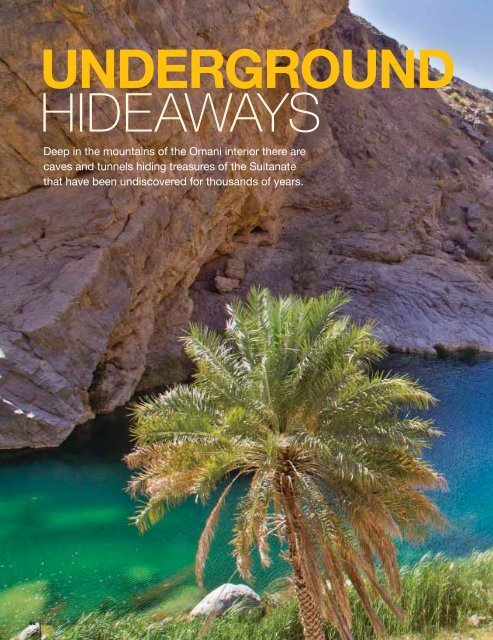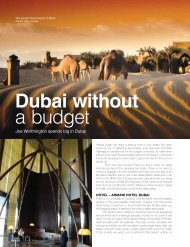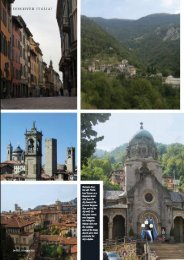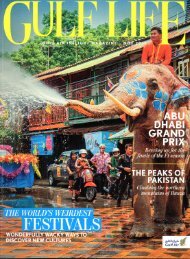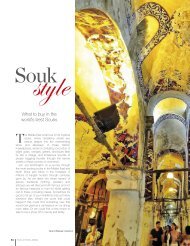Create successful ePaper yourself
Turn your PDF publications into a flip-book with our unique Google optimized e-Paper software.
UNDERGROUND<br />
HIDEAWAYS<br />
Deep in the mountains of the Omani interior there are<br />
caves and tunnels hiding treasures of the Sultanate<br />
that have been undiscovered for thousands of years.<br />
48<br />
FOOD & TRAVEL ARABIA
UNDERGROUND HIDEAWAYS<br />
OMAN<br />
FOOD & TRAVEL ARABIA 49
UNDERGROUND HIDEAWAYS<br />
OMAN<br />
Caving is becoming increasingly popular in Oman, both for locals<br />
and visitors alike. Muscat is the bustling heart of the country, and<br />
Salalah is the natural gem, but you can experience cities in Dubai or<br />
Abu Dhabi; people are coming to Oman for something completely<br />
different, something a little more unusual.<br />
AL HOOTA CAVE<br />
Deep in the mountains surrounding Al Hamra, and at the foot of<br />
Jabal Shams, stands the Al Hoota Cave, the first and only show<br />
cave on the Arabian Peninsula. The 4.5-kilometre-long cave, of<br />
which 500 metres is open to the public, is home to some of the<br />
rarest wildlife in the world.<br />
Over 2 million years, the natural acid in the little rain that falls in<br />
Oman dug away 10mm of rock every 100 years. Tiny holes in the<br />
limestone rock gradually allow drops of water into the cave, creating<br />
all manner of rock formations, ice structures, and pools of fresh<br />
oxygenated water.<br />
To get to the cave visitors have to take a short monorail ride<br />
through the vast mountain range in this part of the country, with<br />
towering sand-covered cliffs and grey caverns for as far as the eye<br />
can see. The monorail journey offers visitors to Al Hoota a glimpse<br />
of what is to come in the cave.<br />
When you start the descent down the steep stone steps the<br />
natural daylight quickly starts to fade, being replaced by a low-level<br />
white glow from the motion sensitive lights on the ground, which<br />
light up when people walk past and turn off when they walk away;<br />
this is to ensure that light pollution doesn’t disturb the wildlife and<br />
algae in the caves.<br />
As you head deeper into the cave, as the temperature drops<br />
further and the air gets harder to breathe, naturally-occurring<br />
stalagmites and stalactites of all shapes and sizes rise from the floor<br />
and drop from the cave roof, casting eerie shadows all around. On<br />
the one side, emerging from the darkness between lights, a natural<br />
rock formation in the shape of a Chinese cat with its hand in a<br />
waving position seemingly appears from nowhere.<br />
Bats screech and flap overhead in the darkness, and crickets,<br />
spiders, scorpions, and beetles scuttle up the walls as you pass by.<br />
Deeper into Al Hoota is perhaps the most famous natural rock formation<br />
in this part of the country, a lion’s head. Look out for the flowing mane,<br />
triangular nose, and cat-shaped head staring at you from the distance<br />
as you head towards the dripping sounds in the distance.<br />
Down a series of metal staircases stands the central pool of the<br />
cave, home to a rare species of fish that cannot be found anywhere<br />
else in the world, and which were only discovered by accident by a<br />
goat herder less than 100 years ago. The small ghost-white fish, all<br />
of which are blind, dart across the pond, reacting to the sounds of<br />
dripping water and footsteps shaking the ground. The official name<br />
of these fish is Garra Barreimiae, but the locals refer to them as Bu<br />
Naseh and his friends. Some people like to dip their feet into the<br />
chilly pond water, but others prefer to just stand and admire the<br />
beautiful surroundings.<br />
MUQAL CAVE<br />
The Al Hoota Cave has been set-up for tourists, but for something a<br />
little more natural and authentic, visitors should head to Muqal Cave<br />
in Wadi Bani Khalid, next to the famous Muqal water pools. There<br />
are no metal steps or monorails here, so wearing hiking boots is<br />
highly recommended for the unsteady ground.<br />
When you first enter the huge cavernous opening in the rocks<br />
you will be immediately hit by the thundering roar of water crashing<br />
through the channels deeper in the cave, and the water spray<br />
hitting your face. There are no lights in Muqal Cave, so bring a torch<br />
so that you can see the critters crawling around, and the unusual<br />
cracks and crevices in the cave walls. Look out for the narrow<br />
sections, you may need to duck down!<br />
Follow the sound of the flowing streams inside the cave and<br />
venture deeper into the darkness. Turn off your torch and stand<br />
still on the spot. Feel the vibrations under your feet as the water<br />
crashes through the rocks, and the spray hitting your skin. Listen to<br />
the screeches and squeaks of the creatures around you, and take<br />
some time for yourself. Forget about the outside world for a few<br />
seconds and enjoy the tranquillity.<br />
50<br />
FOOD & TRAVEL ARABIA
Opposite page, left to right: Frankincense farm in Salalah Oman;<br />
Signage; Al Hoota Cave stalagmites and stalactites; Wahiba sands<br />
Oman; Al Hoota Cave’s lion head natural rock formation.<br />
Wadi Bani Khalid<br />
Deep in the Hajar Mountains, in the northeast of<br />
Oman bordering Ras Al Khaimah, is Wadi Bani Khalid.<br />
The tranquil turquoise streams and lakes in this<br />
part of the country are well worth the effort needed<br />
to get here, but the hidden cave systems are even<br />
more spectacular. The vast pure water lakes of Ain<br />
Hamouda, Ain al Sarooj, and Ain Dawwa have allowed<br />
lush foliage to grow across Wadi Bani Khalid, but they<br />
have also permeated through thick rocks, leaving<br />
behind millennia-old tunnels.<br />
The caves here were once used by local bandits who<br />
needed somewhere to hide their loot, and before that<br />
tribal rulers and kings were thought to hide out in the<br />
tunnel systems awaiting attacks from rivals. Between<br />
the caves are hidden oases of tepid water, offering a<br />
refreshing release from the hot and dusty air outside.<br />
The landscape in the Hajars in simply out of this<br />
world; grey limstrone crags, cliffs topped with grass<br />
and bushes, and neat rows of trees following the paths<br />
of streams as they trickle down the mountainsides.<br />
FOOD & TRAVEL ARABIA 51
UNDERGROUND HIDEAWAYS<br />
OMAN<br />
Words by Joe Worthington. Images by Food & Travel Arabia & Oman Tourism<br />
MAJLIS AL JINN<br />
The largest caves in Oman are well worth saving to the end,<br />
and they don’t get much bigger than at Majlis Al Jinn. Arabian<br />
legend has it that mythical creatures called the Jinn, or genies<br />
in English, met in these caves in ancient times, and the central<br />
chamber called “the Cathedral” because of its 120-metre depth<br />
and domed roof is where they are supposed to have convened.<br />
Entry to the cave is not for the faint hearted, you have to<br />
descend through one of the two entrances. The first entrance,<br />
called Asterisk (Khoshilat Beya Al Hiyool), is 136.9 metres<br />
deep. The second, First Drop (Khoshilat Maqandeli) is 118<br />
metres deep. Whereas most caves around the world are small,<br />
cramped chamber, the ones at Majlis Al Jinn are bigger than<br />
most people’s houses – they really are huge!<br />
When narrow beams of light shine through holes in the top<br />
of the caves, and the glistening water droplets shine on the<br />
speleothems on the cave floors, there is nowhere better on<br />
earth to spend the day. The Cathedral cave and beams of light<br />
from above are like a sign from God that this is a haven of<br />
peace and tranquillity in the Omani wilderness.<br />
Caving in the Sultanate’s secret caves is a much-needed<br />
retreat for visitors to the edge of the Arabian Peninsula. The<br />
only sounds in the caves of Oman are flowing streams and<br />
scuttling creatures. The temperatures are much lower and<br />
more bearable than outside. And the sights of natural stone<br />
creatures and bright beams of sunlight shining onto the cave<br />
floor are unlike anything else in the Gulf. The caves of Oman are<br />
relatively undiscovered by tourists, and that’s why they really are<br />
the Sultan’s underground hideaways.<br />
52<br />
FOOD & TRAVEL ARABIA


